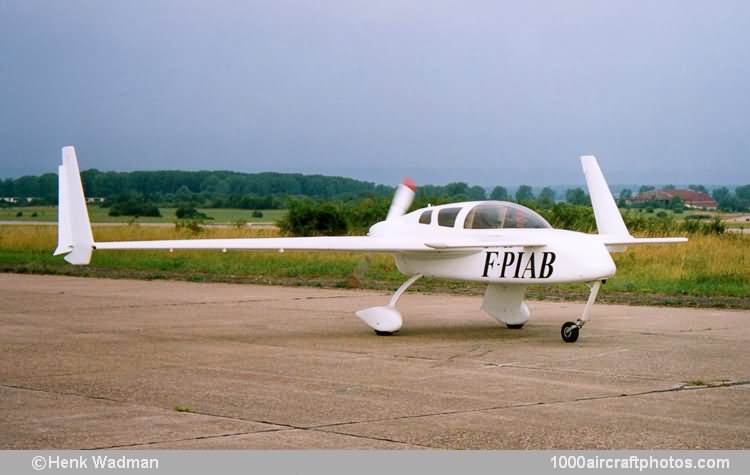11/30/2010. Remarks by Walter van Tilborg: "Nathan 'Nat' D. Puffer initiated development, with the consent of Burt Rutan, of a sporting aircraft known as the Cozy, as a side-by-side two-seat development of the Rutan Long-EZ. The Cozy was intended originally to be a 'one-of-a-kind', however, following consultations with the Rutan Aircraft Factory, Puffer received a license to market the Cozy. For this purpose, the Co. Z Development Corporation was established at Mesa, Arizona, USA.
Design began in January 1980 and construction of the prototype started in the following July. The Cozy had a wider cabin and forward fuselage section with side-by-side seating and an optional third seat. Powered by an 118 hp Lycoming O-235-L2C engine, the first flight was achieved on July 19, 1982. Dimensions included 26 ft 1.25 in (7.96 m) wingspan and 16 ft 9.5 in (5.12m) overall length. Plans for amateur construction were marketed, and an estimated 200+ aircraft have been flown, although in a number of variants, included in the following summary.
Cozy. The initial three-seat version developed for amateur construction. The first plans-built example was built in the USA by German AF pilot Ulrich 'Uli' Wolters and his wife Linda. Powered by an 160 hp Lycoming O-320-D2E engine, and registered N52CZ (c/n 001), it was first flown on June, 19, 1985. It differed from standard by modifications to the canard and nose gear doors, while the cockpit canopy was arranged to open further and wing span was increased by 1 in (2.54 cm) to 26 ft 2.25 in (7.98 m).
Cosy Classic. In 1987, Wolters acquired all Cosy rights for marketing in Europe, and founded Co-Europe (later renamed Cosy Europe) to offer the design as the Cosy Classic. Several aircraft were built, with engines in the 120-180 hp range.
Cozy Mk.III. Designation used by Co-Z Development Corporation for marketing the Cosy Classic.
Cozy Mk.IV. Full four-seater developed by Nat Puffer with an again wider cabin, and increased dimensions: span 28 ft 1 in (8.56 m), length 17ft 0 in (5.18 m), height 7 ft 9 in (2.36 m). The first example was constructed by the designer with an 180 hp Lycoming O-360 and flown in 1988. He also constructed the first plans-built Cozy Mk.IV, which was flown in 1992. Marketed by the Co-Z Development Corporation, the Cozy Mk.IV was suited for 160-200 hp IO-320 and O-360 series engines. The pictured Cozy Mk.IV was built by Alexandre Barjon of Calas, France, and first flew Augustus 9, 1998.
Cozy Mk.III-RG/Cozy Mk.IV-RG. These designations were used for Cozy Mk.III and Cozy Mk.IV aircraft which were fitted with a retractable landing gear. The first Cozy Mk.IV-RG was flown during 2004.
Twin Cozy. The brothers Ruben and Carlos Leon of Valencia, Venezuela, built a Cozy fitted with two 100 hp 1,600 cc Suzuki Swift motorcar engines, placed side-by-side and each driving a three-bladed (contra-rotating) propeller. Registered YV-22X (c/n 0308), this aircraft was first flown on February 1, 1996.
Kinda Cozy RG. Modified Cozy Mk.IV RG of Phillip Johnson in Canada. It had a 230 hp Subaru EG33 automotive engine, gull-wing type entry door and many other refinements. The aircraft first flew during the early-2000s.
Cozyjet. A much modified aircraft completed by Gregory W. Richter of Copperhill, Tennessee, USA. Initially powered by a Mazda 13B rotary engine driving a shrouded propeller, and registered N722, it first flew in 2000. The aircraft was later fitted with an 800 lb (363 kg) st GE T58-8F turbine engine (modified from a T58 propeller turbine) and flew in that guise during 2001. The aircraft featured two small flush fitted shoulder air intakes on each side, a modified and slightly longer rear fuselage.
Fish Eagle. After a building period of 13 years and 4 months, and registered as ZU-BNH, Rego Burger of Port Elizabeth, South Africa, flew the Fish Eagle, a modified Cozy Mk.IV powered by a modified V8 car engine, on March 5, 2006. Unfortunately, just three months later and after 35.6 flying hours, the aircraft was severely damaged at the Port Alfred Aerodrome on June 16, 2006. The pilot decided to abort the take off when the aircraft was unable to accelerate on the damp, grass covered runway. As a result of the rough surface of the overrun area, the nose wheel assembly failed, while the right wing hit a tree, subsequently the aircraft nosed over. The pilot sustained no injuries, the fate of the aircraft is unknown.
AURA. A project of BMO (US Airforce Ballistic Missile Organization) and Aeromet, Inc. that was started around 1986, the AURA (Autonomous Unmanned Reconnaissance Aircraft) was considered as the first remotely controlled, including auto-landings, UAV although it was officially an OPV (Optionally Piloted Vehicle) as it had provision for a pilot. Two civil registered (N11AU c/n 001, N16AU c/n 002) AURA aircraft were built by Aeromet and these were modified Cozy Mk.V airframes. The aircrafts were powered by an 115 hp Lycoming O-235 piston engine and had an endurance of up to 12 hours."
